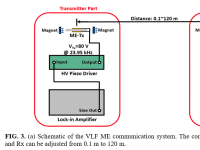
<Motivation and Innovation>
Radio frequency (RF) technologies have limitations that cannot fulfill specific requirements. For instance, underground and underwater are challenging environments due to the absorption of high frequency electromagnetic (EM) waves in dense media. For hypersonic communications, Very Low Frequencies (VLF) band signals have large EM wavelengths that can penetrate the plasma sheath layer with minimal loss, which is one of the well-known solutions in the community. However, conventional antennas rely on EM wave resonance, and therefore typically have a size of more than one-tenth of the EM wavelength, which is 10 to 100 km long at VLF band. Therefore, even an electrically small VLF antenna would have huge dimensions and enormous power consumption, which is impractical to put in the vehicles. Here we propose an ultra-compact VLF communication system for underground, underwater, and hypersonic flight applications. These ME antennas with 2 to 3 orders size reduction will have great potential for most VLF applications with low cost and low power consumption.
<Technical Approach and Preliminary Results>
The approach is based on the magnetoelectric antennas minimization mechanism, which won the NASA Tech Briefs-Create the Future Design Contest: First Prize in Electronics/Sensors/IoT Category in 2018. The VLF antenna doesn’t require the micro-fabrication process, which is easy to implement and manufacture. Our preliminary result at 120 meters distance can reach 23 kbit/sec by direct antenna modulation with 400 mW low power consumption, where the antenna volume itself is only 0.3 cm3. By new design and materials, vacuum packaging, parametric pumping technique, and antenna arrays design, we are confident to accomplish and demonstrate >30 kbit/sec through the harsh environments with <20W low power consumption, where the antenna array volume is < 3000 cm3 at the distance of 10~100km.
<Customer Needs and Market>
We have strong market demands on ME antennas (including VLF, VHF, and UHF frequency bands), ranging from large corporates such as SONY, Raytheon, Analog Devices Inc., Boeing to many small businesses. We have signed >20 NDA with these companies and with VCs for product validation. The total addressable antenna market is estimated to be $22.5B in 2021 with 6% CAGR. Specifically, the VLF magnetoelectric antennas will focus on the following two sectors: (1) Aerospace & Defense; and (2) Industrials / IoT.
Our preliminary interaction with the industry specialists from “Lockheed Martin Missile and Fire Control”; and “BAE Systems” showed serious interest of the defense-related industry to the technology of magnetoelectric antennas to develop, to mature the VLF Communication system, and to provide relevant test conditions, requirements, and evaluation facilities. The anticipated benefits and potential commercial applications of the research and development on VLF antennas and VLF communication systems with ultra-low SWAP-C are enormous. The system will be mobile and can be powered by a battery and will enable continuous communication in hypersonic vehicles. At the same time, these novel VLF communication systems will enable underwater and underground communications at unprecedented long distances that are impossible for conventional communication technologies and will significantly benefit the military as well as civilian applications.
-
Awards
-
 2019 Top 100 Entries
2019 Top 100 Entries
Like this entry?
-
About the Entrant
- Name:Hwaider Lin
- Type of entry:teamTeam members:Cunzheng Dong (Northeastern University)
Yifan He (Northeastern University)
Hwaider Lin (Winchester Technologies, LLC)
Nian-Xiang Sun (Northeastern University) - Patent status:patented





